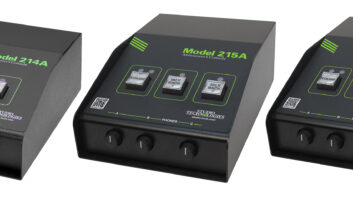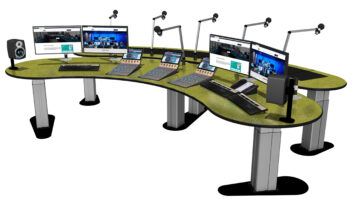Phillip Vaughan is chief engineer of the five-station Entercom Riverside cluster in Colton, Calif. Years ago, Phillip writes, he was working for a station that had security cameras installed at a transmitter site. At some point the building was broken into, and unfortunately, the DVR was stolen along with a few other things. The burglars ransacked the place, leaving a huge mess! Of course, the camera system was useless because the DVR had been stolen.
Recently, he installed security cameras at a couple of his sites to help protect against vandalism and copper theft. Because of the lesson learned earlier in his career as well as changes in IP technology over the years, he almost always backhauls the video feeds to a DVR located off site, primarily at the studio.
Because most stations have some kind of wireless IP bridge between the studio and transmitter site, keeping the DVR at the studio should not be a problem. Even the cost of installing an unlicensed set of radios would be worth looking into to make sure your site stays secure.
Phillip adds this note about site security cameras: Make sure you set up the “email upon disconnection” feature. This will send you an email or text message when one of your cameras becomes disconnected, allowing you to know instantly if your system is being stolen or vandalized.
***
We’ll put this in the “duh” category: Be careful when changing out UPS batteries.
So-called “sealed” batteries can become “unsealed” after a few years. Seasoned broadcast engineer Kirk Chestnut found this out the hard way.
The unit in question went four years on the same set of cells. Kirk thought he was being careful as he removed the batteries but never noticed that the electrolyte was dripping on his trousers, as shown in Fig. 1 — and the liquid was not condensate in the battery tray, either.

Kirk adds that the fumes can be just as hazardous, so use caution.
***
Jim Arcaro, WD8PFK, read our recent tip about using an eraser for contact cleaning. It’s been Jim’s practice to follow that process by cleaning the area with a cotton swab dipped in 91 percent isopropyl alcohol to remove any residue.
And if the area being cleaned was larger or needed scrubbing, Jim uses a clean toothbrush or Crocus Cloth — still available at local hardware stores.
Jim uses the 91-percent alcohol everywhere, except where there is existing heat or flame. If heat is expected, let the surface dry first before applying power. Also, make sure there is adequate ventilation to air out the fumes.
***
Fig. 2 shows an adaptor that project engineer Dan Slentz found. There is also a longer version, shown in Fig. 3.

The LyxPro TRRS to XLR connector has an XLR female that allows you to connect a professional microphone with XLR connectors — like a LyxPro HHMX-10, HHMX-15, Shure SM58 or Sennheiser E835 — to an iPhone or other compatible device for professional recording. Use this instead of relying on the phone’s built-in microphone, and you’ll get much better results.

In addition, the adaptor features a jack to connect any stereo headphones to monitor the recording if your app allows that. Since this cable does not provide phantom power, microphones that require phantom will not work with this cable, unless the microphone uses their own power or a phantom power supply.
Both dynamic microphones, condenser and shotgun microphones that provide their own phantom power work well. The result is a “ready-to-go” remote kit for the smartphone, shown in Fig. 4, as long as there’s a mic/headphone jack.

Contribute to Workbench. You’ll help fellow engineers, and qualify for SBE recertification credit. Send Workbench tips and high-resolution photos to [email protected]. Fax to (603) 472-4944.
Author John Bisset has spent 48 years in the broadcasting industry and is still learning. He handles western U.S. radio sales for the Telos Alliance. He is SBE certified and a past recipient of the SBE’s Educator of the Year Award.












